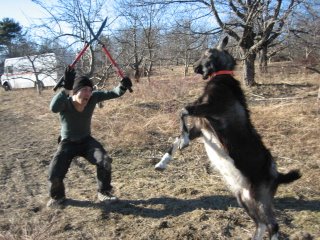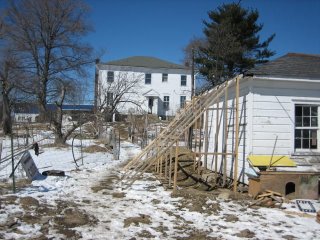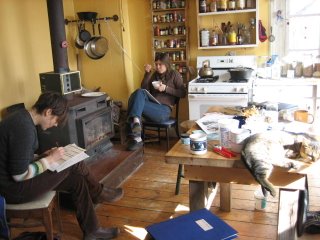From the New York Times THursday Home and Garden Section.
March 9, 2006
Essay
Inviting Anarchy Into My Home
By LIZ SEYMOUR
Greensboro, N.C.
ON Aug. 1, 2002, I left behind the comfortably roomy semicircle marked "married-couple household" on the Census Bureau pie chart and slipped into an inconspicuous wedge labeled "two or more people, nonfamily." Having separated from my husband of 28 years the day before, I opened our three-bedroom 1927 Colonial Revival house to a group of men and women less than half my age. Overnight, the home I had lived in for 12 years became a seven-person anarchist collective, run by consensus and fueled by punk music, curse-studded conversation and food scavenged from Dumpsters.
Thoreau famously said that he had "traveled much in Concord." I would venture to say that I've traveled just as much, and maybe more, without ever leaving my house.
It happened like this: My husband and I had come to the end of the line, as married people sometimes do. We had helped each other into adulthood and careers (Bill is a high school English teacher; I'm a freelance writer). We had raised two daughters together, but with Isabell and Margaret grown and both of us entering our 50's, it was clear that our hopes and goals for the next couple of decades were diverging.
Bill longed for quiet and solitude; I wanted noise and movement. To complicate matters, I had become the court advocate for Justin, a 15-year-old runaway from a foster home who had been in and out of juvenile detention since he was 12. After a year of trying to find a workable home for him, I had concluded that the only recourse was to be his foster mother myself.
Now, faced with the prospect of becoming a 52-year-old single mother to a teenage boy and the challenge of supporting us both, I panicked. Trying to imagine how I could make it work, I found my mind turning to a collective house in Oregon where Isabell, my older daughter, had lived the summer before, and to a group of young anarchist artists and musicians in Greensboro whom I knew through both of my daughters.
After Isabell came home from college an anarchist herself, I began to put aside my preconceptions about these people — as disorderly, violent and destructive — and to see them as a community dedicated to replacing hierarchy with consensus and cooperation. (Isabell once described them as Quakers who swear a lot.) Over time I found myself drawn to their hopeful view that people know best what is best for them and to their determination, naïve or not, to build a better world right away. Anarchism, at least as practiced here, seemed to be more about building community gardens and making your own fun than about black bandannas and confrontations with the riot police (although it was about those things, too).
Amid the chaos of my own life I wondered if this approach to living might have something in it for me. Unconventional as it was, I figured it couldn't be any worse than struggling to pay the mortgage and being Justin's mother on my own.
So Justin and I entered a microeconomy in which it is possible to live not just comfortably, but well, on $500 a month. When we pooled our skills in our new household, we found that we had what we needed to design a Web page, paint a ceiling or install a car stereo. Sharing services and tools with people outside the house saved us thousands of dollars a year. If there is a historical model for the way we live, it is not the communes of the 60's or the utopian experiments of the 19th century, but the two-million-year prehistory of our hunting-and-gathering ancestors. Looked at through that lens, the life of our miniature tribe feels a lot like the way people were meant to live.
That account, of course, leaves out the terror I felt through the summer of 2002 as I prepared to open my house to anarchy. Also the occasional awful days and nights early in the experiment, like the evening that began with Justin's skateboard at the bottom of the stairs and that ended with shouting, slammed doors and the skateboard flying out a second-story window. Then there were the guests who wouldn't leave; the short-lived but horrifying rat invasion (brought on, I suspect, by boxes of food from Dumpsters on the back porch); and the friends who drifted out of my life, baffled by my new living arrangements.
I still own about two-thirds of the house, sharing the title with two young women in the collective, Mackie Hunter, a 25-year-old full-time political activist who had an insurance settlement to invest, and Stef Smith, a 26-year-old drummer with a never-to-be-used college fund. Their investment, and my refinancing of the house, allowed me to buy out Bill after we divorced two years ago, and gave them about a third share of the property. Since I do not want to profit from the collective as its landlady, I have decided that the portion of the equity that builds up from my housemates' monthly rent will not go to me if the house is sold or refinanced, but will serve to help keep the collective going. In essence I've converted my capital from the house to the household. Twenty years from now, when I'm in my mid-70's, I may regret giving up my equity in return for time and community, but I don't think so. I'd rather take my retirement now.
The ages in the house span 50 years, from Jodi Staley's 6-year-old daughter, Skye, to me. Justin, now 18, moved out more than a year ago to live with his girlfriend; he hopes to go to a music conservatory. (He turned out to be one of those children it takes a village to raise, and he not only thrived under the group's care but rebelled into surprisingly mainstream respectability.)
None of us work full time. We support ourselves by painting houses, typing legal depositions, teaching (as substitutes), subjecting ourselves to medical studies, cooking in restaurants and writing. The time I save allows me to help care for an elderly relative, cook for a free meal program, spend time with friends and work on a book.
On paper we look like paupers. The monthly cost of living in the house comes to $160 to $245 a person, based on the size of one's bedroom. That includes the mortgage, property taxes, household insurance, utilities (we have an unlimited long-distance plan) and wireless Internet. In addition we each put $30 a month into a house fund that pays for bulk food like rice, beans, olive oil and spices, and supplies like toilet paper, light bulbs and laundry detergent.
As for produce, a typical evening of hunting and gathering in various grocery store Dumpsters brings in plenty of food: cartons of apples, oranges, potatoes, bananas and red onions, slightly soft or spotty perhaps, but still fresh and edible.
Every Sunday it is someone's turn to fix dinner while the rest of us sweep and mop, with Al Green or the Pixies blasting from the kitchen stereo. Since the dining room has been turned into a bedroom (as have the downstairs study and a small upstairs room that was my office), we eat on the screened-in side porch or in the backyard under the crape myrtle tree when the weather is warm, or around the kitchen table or in the living room when it is cool.
On Tuesday night we hold the weekly house meeting. It is surprisingly helpful to know who has a headache, who just fell in love, who is sleepy. More than one set of roommates have blown apart over dishes piled up in the sink and wet towels left on the bathroom floor; then again, so have quite a few nuclear families. We talk things out.
Though our daily activities are a lot closer to the Waltons than to the Weather Underground, we keep "In Case of Police Raid" instructions posted by our front and back doors. It is a reminder that houses like ours in other towns do get raided.
In spite of the stigma attached to the word "anarchist" and the scrutiny openly anarchist households receive, the number of such houses is growing. Anarchists are no longer just in college towns and big cities; there are now thriving anarchist communities and houses like ours in places like Lake Worth, Fla.; Machias, Me.; and Springfield, Mo. The online directory maintained by the Fellowship for Intentional Community lists more than 1,000 collective houses, ecovillages and co-ops in the United States, compared with about 400 in the 1990 directory. Although not all of them identify themselves as anarchist, more than half make their decisions by consensus. Even that number is clearly low: none of the five collective houses I know of in Greensboro, for example, are listed in the directory.
It is a rare week when we do not have at least one guest in residence. One winter we had a Danish filmmaker living in the garage. On a rainy night last spring an entire old-time string band showed up on the doorstep. The musicians had been hopping freight trains around the country and gotten stranded; they played fiddle, banjo and musical saw in the living room and left the next day. Another guest walked from Maine to North Carolina, the first leg of a trip home to Oregon. He stayed for a week, mended some rips in his backpack, then walked off down the driveway due west.
I have friends who tell me they could not live the way I do. I believe them. The constant sound of footsteps on the stairs, the coffee cups in the sink, the mysterious things in the refrigerator that no one claims, the sheer intensity some days of so many personalities rubbing up against one another, is not for everyone. But then neither are more conventional living arrangements. For me, a household of friends — more loosely bound than a family but tied together by loyalty, affinity and shared space — satisfies a need for kinship and companionship that did not end when my family did.
The old house's former incarnation as a middle-class, nuclear-family household still rises up in my mind now and then. Someone will ask about an umbrella or a bottle of aspirin or a pair of needle nose pliers, and I'll picture so clearly the place where the object used to be that for a moment I'm there instead of here. It is not an unpleasant sensation, just a little strange.
For the most part, though, my memory keeps up a pretty sturdy firewall between the time I have come to think of as "before" and now. Where I live now is not utopia. What it is, though, is fun. It is fun to hear people laughing on the porch; it is fun to dance in the kitchen; it is fun to go out on a Wednesday evening Dumpster run. As messy as it is, to my mind it is a lot more interesting than utopia could ever be.
here was kaya's mom's response
March 11, 2006
To the Editor:
In reference to “Inviting Anarchy Into My Home” by Liz Seymour, Essay, House and Home Section; Thursday, March 9, 2006:
“Anarchy” is often considered a dirty word in the media, usually appearing in the same sentence with “chaos” and “destruction”. But like my fellow baby boomer Liz Seymour, I have discovered there is an impressive network of “self-styled” anarchists out there. These resourceful young people are dedicated to old-fashioned values such as building community and standing up for justice and personal responsibility. They carry forward our generation’s legacy of the civil rights, peace and environmental movements. Their biggest crime is refusing to participate in the energy-gobbling and soul-robbing consumer culture. They should be considered our brightest hope for survival into the future.
Melissa Roberts Weidman






